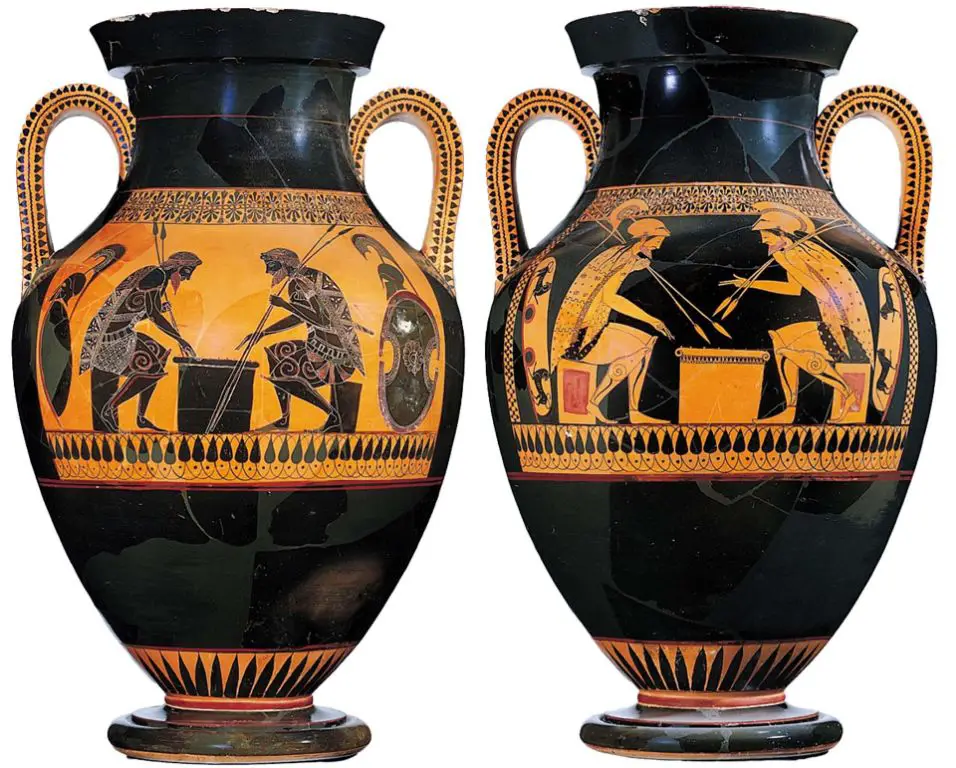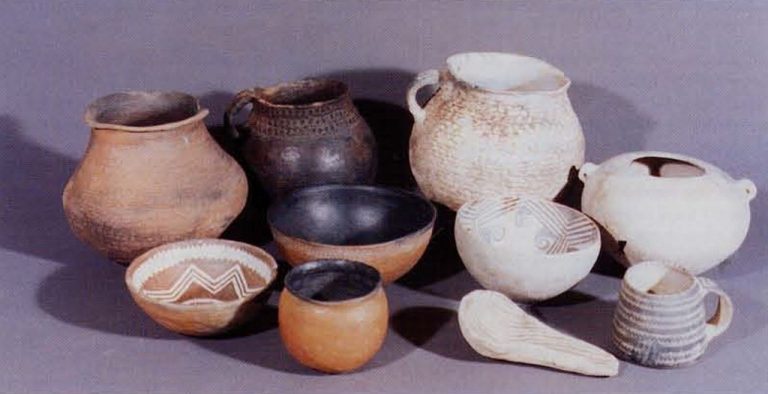What Is The Difference Between Pottery And Ceramics?
Pottery and ceramics are often used interchangeably, but they actually refer to different types of objects made from clay that have been fired in a kiln. While there is some overlap between the two terms, there are also some key differences.
Pottery broadly refers to functional clay objects like dishes, bowls, mugs, and vases that are made from clay, hardened by firing, and often glazed or painted. Pottery is made to serve daily practical purposes like storing, serving, and cooking food and liquids. (Wikipedia)
Ceramics, on the other hand, encompasses all objects made from clay that are fired at high temperatures, including pottery as well as sculptures, tiles, and other art objects. While ceramics can be functional, they are often decorative, artistic, or made purely for aesthetic purposes. Ceramics expands beyond just pottery to include a wide array of clay art.
Materials
The key material that distinguishes pottery from ceramics is the type of clay used. Pottery is made from earthenware clays, which are less refined and have lower firing temperatures. These clays contain more impurities and are softer when fired. Common earthenware clays used for pottery include:
- Terracotta
- Red clay
- Brown clay
- White clay
In contrast, ceramics are made from more purified clays that can withstand much higher firing temperatures. These include:
- Stoneware clay
- Porcelain clay
- Bone china clay
The precise mineral composition gives these clays their white color and durability characteristics. The purity allows thinner walls and refined glazing effects. So the type of clay used is a key factor distinguishing pottery from higher-fired ceramics.
Firing Temperatures
Pottery and ceramics are fired at different temperatures depending on the type of clay used. Pottery is generally fired at lower temperatures ranging from 1752°F to 2102°F (950°C to 1150°C) for earthenware clays, and 2012°F to 2282°F (1100°C to 1250°C) for stoneware clays. Ceramics are fired at much higher temperatures from 2192°F to 2462°F (1200°C to 1350°C).
Earthenware pottery uses low-fire clays that mature at temperatures below 2102°F (1150°C). According to the Kiln Firing Chart, earthenware firing ranges from 1752-2012°F (950-1100°C) [1]. Stoneware pottery uses mid-range fire clays that mature between 2012-2282°F (1100-1250°C). The average firing temperature for stoneware pottery is around 2381°F (1305°C) [2].
In comparison, ceramics use high-fire clays and are fired at much higher temperatures. Ceramic ware is typically fired between 2192-2462°F (1200-1350°C) according to industry standards. These high temperatures result in more durable and watertight ceramic pieces.
Uses
Pottery and ceramics have many similar uses, but also some differences due to their unique properties. Some typical uses of pottery include:
- Cooking ware – From ancient times until today, pottery has been a popular material for cooking vessels and containers due to its heat resistance. Many unglazed clay pots are still used for cooking.
- Tableware – Glazed and decorated pottery has long been used to serve food and for dining. From ancient amphorae to modern dinner plates, pottery is an ideal material for tableware.
- Water storage – Porous, unglazed pottery is excellent for cooling water in hot climates. Unglazed clay pots allow evaporation through the walls, cooling stored water.
Ceramics also have many uses, some overlapping with pottery:
- Tile – Glazed ceramic tiles cover walls, floors, countertops, and more. Ceramic’s durability, water-resistance, and endless decorative effects make tile very popular.
- Sanitaryware – From toilets to sinks to bathtubs, vitreous china ceramic is the material of choice for sanitary fixtures.
- Tableware – Like pottery, high-fired ceramics make excellent plates, cups, bowls and more. The range of glazes and designs is endless.
- Electrical – Ceramics are used to make insulators, semiconductors, and other electrical components.
While pottery and ceramics overlap in uses like tableware, their differing qualities make each material preferable for certain applications.
Decoration
Both pottery and ceramics can be decorated in various ways to add color, texture, and design. Some common decoration techniques include:
Glazing – Applying a glassy coating over the clay and firing it again to melt the glaze. Glazes come in various colors and finishes like glossy or matte. According to Pottery Decoration, glazing is one of the most popular ways to decorate ceramic ware and pottery.
Painting – Applying colored pigments directly onto the clay surface. Pottery painters often use mineral pigments and oxides that can withstand high firing temperatures. Ceramic paints usually require a second firing to make the colors permanent. Painting allows for intricate designs.
Slip Trailing – Using liquid clay slip to draw or trail decorative patterns onto leather-hard clay. The slip trails fuse with the base clay after firing. Slip trailing provides raised texture and line designs.
Carving/Incising – Cutting into the clay surface to create texture or images. Leather-hard clay can be carved using various tools. Carving creates sunken decorations.
Mishima – Inlaying colored slip into carved line designs in leather-hard clay. The carved lines are filled with colored slip and then wiped clean, leaving just the inlaid slip color behind.
Decals – Applying ceramic decals, which have ceramic color pigments printed onto paper or film, onto the clay surface. The decals fuse into the glaze firing.
Sponging – Using sponge shapes or sea sponges to apply color. Sponging creates soft mottled effects.
Stamping – Impressing designs into the clay using rubber stamps or carved items. Stamped impressions create repetitive designs.
Sgraffito – Scratching through a layer of colored slip to reveal the clay color underneath. Sgraffito provides bold contrasting lines.
There are endless ways potters and ceramic artists add creative flair to their pieces through decoration. Both pottery and ceramic wares showcase unique decoration effects and colors.
History
The origins of pottery and ceramics date back thousands of years. Archaeological evidence indicates that pottery was independently invented in many early civilizations, with artifacts found dating back over 20,000 years in China and Japan, and over 18,000 years in Eastern Europe.[1] The earliest known pottery vessels were made in China during the Palaeolithic period, and in Japan during the Jōmon period. [2]

The oldest pottery found in the Near East dates back to 7000-6500 BCE in the Pre-Pottery Neolithic A period. [3] Pottery began showing up in the Minoan civilization of Crete and mainland Greece around 4000 BCE. [2] In Northern Africa, ancient Egyptians started making pottery around 4000 BCE. [1] The ancient Greeks made pottery from around 6500 years ago, with black figure pottery and red figure pottery styles becoming popular during the 6th century BCE.
Early Mesopotamian pottery dates back to 6000 BCE. [1] The earliest ceramics made in the Americas date back to 2500 to 3000 BCE and originated in South America. [2] The earliest ceramics known in the United States are from the Late Archaic Period around 4000-1000 BCE.
The major difference between the origins of pottery and ceramics is that pottery refers to objects made from clay that is hardened at low temperatures, while ceramics are made from clay and other materials fired at high temperatures. The higher temperatures make ceramics more durable than pottery.
[1] http://www.historyworld.net/wrldhis/PlainTextHistoriesB.asp?groupid=2147&HistoryID=ab98
[2] https://universeofceramics.com/history-pottery/
[3] http://www.pottery-on-the-wheel.com/history-of-ceramics.html
Manufacturing
Pottery and ceramics are both made from clay that is shaped and then hardened through firing, but the manufacturing process differs slightly between the two. Pottery is made from clay, water, and often some natural additives like sand or crushed seashells. The clay is hand formed or thrown on a potter’s wheel into the desired shape, then allowed to air dry to a leather-hard state before firing. Pottery is fired at lower temperatures, usually below 2,200°F (1,200°C). This allows the clay to retain its porous, permeable nature.
Ceramics start with more refined clay that produces a less porous product. The clay is shaped by hand or machine press and then dried. Glazes are often applied before an initial bisque firing at around 1,800°F (1,000°C) to harden the piece. After glazing, ceramics are fired at higher temperatures above 2,200°F (1,200°C) to fully fuse and vitrify the clay into an impermeable, glass-like substance. The higher heat allows ceramic glazes to melt and adhere to the clay body.
Pottery is made in small batches by hand with simple equipment, while ceramics are mass-produced using industrial methods and machinery. However, artisans may also handcraft ceramic wares in a pottery studio setting. Overall, ceramics require more controlled refinement of the clay and glazes as well as hotter kiln temperatures in the manufacturing process compared to pottery.
Notable Styles
Japan has a long history of pottery and ceramic styles that have become famous worldwide. Some of the most notable include:
Raku ware – Originating in the 16th century, Raku ware involves removing pottery from the kiln while still glowing hot and placing it into containers with combustible materials like sawdust. This produces pottery with a unique cracked glaze.
Kintsugi – The Japanese art of repairing broken pottery with lacquer resin mixed with powdered gold, silver or platinum. The repair work becomes part of the pottery’s design.
Satsuma ware – Originating in southern Japan in the late 16th century, Satsuma ware features hand-painted motifs and intricate gold decorations on a white background.
Bizen ware – Simple, unglazed stoneware from Okayama prefecture known for its use of local clay and wood-burning kilns. Valued for its natural rustic aesthetic.
Seto ware – Pottery and ceramics from the Seto region, known for pioneering glazing techniques as early as the 12th century. Often in earthy, subdued colors.
Kyō ware – Elegant porcelain produced in Kyoto since the late 16th century, known for its translucent white glaze and simple, refined aesthetic.
Notable Artists
Pottery and ceramics have a long history across many cultures, so there are countless notable artists who have made significant contributions. Here are some of the most famous potters and ceramicists through history:
Some of the earliest known potters include the Ancient Greeks, such as Exekias, known for his black-figure pottery, and the famous potter Euphronios. In China, Jingdezhen was an important center for ceramic production and artists like He Chaozong became renowned for their skill.
In Europe during the Arts and Crafts movement, Bernard Leach brought Japanese styles like Raku ware back to England. His student, Lucie Rie, also became an accomplished studio potter. Other notable European ceramicists include Josiah Wedgwood, who industrialized pottery production, and Hans Coper’s abstract sculptural works.
Some of the best-known American potters include Maria Martinez famous for black ware pottery and Eva Zeisel’s mid century modern ceramic designs. Contemporary ceramic artists like Peter Voulkos pushed the boundaries of traditional pottery. Other renowned ceramicists today include Clare Twomey, Grayson Perry, and Ai Weiwei.
While styles and techniques have evolved enormously, pottery and ceramics owe much to the creativity and skills of these artists through history.
Conclusion
In summary, there are a few key differences between pottery and ceramics:
- Pottery is made from clay and other natural minerals, while ceramics can also contain synthetic and industrial components.
- Pottery is fired at lower temperatures (up to around 2,300°F) than ceramics, which are fired at over 2,300°F.
- Pottery tends to serve more functional purposes like cookware, storage containers, or vases. Ceramics are used for art, tiles, electronics, and other specialized applications.
- Pottery often has a handmade artisanal look, while ceramics can have a more industrial and precision-engineered appearance.
- The ceramics category encompasses pottery, so all pottery is ceramics but not all ceramics are pottery.
While they share similarities and overlap, the higher firing temperatures, expanded uses, and synthetic materials involved in ceramics distinguish them from traditional clay pottery.

